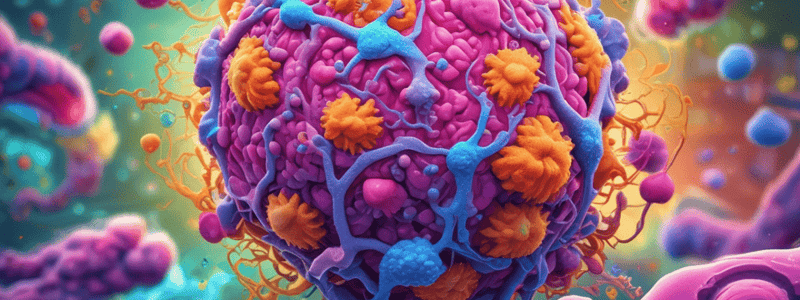Podcast
Questions and Answers
What is the stage of the infectious disease cycle where the host is infectious but does not exhibit clinical signs?
What is the stage of the infectious disease cycle where the host is infectious but does not exhibit clinical signs?
- Latent period
- Infectious period
- Subclinical infectious period (correct)
- Incubation period
Which of the following best describes the relationship between pathogenicity and virulence?
Which of the following best describes the relationship between pathogenicity and virulence?
- Pathogenicity and virulence are synonymous terms that refer to the potential of a virus to cause disease in a host.
- Pathogenicity is a measure of the virus's ability to enter and replicate within host cells, while virulence is a measure of the host's ability to mount an immune response.
- Pathogenicity refers to the ability of a virus to infect a host, while virulence describes the host's immune response to the virus.
- Pathogenicity is a qualitative measure of a virus's ability to cause disease, while virulence is a quantitative measure of the severity of the disease caused. (correct)
What is the term used to describe the range of tissues that a virus can infect?
What is the term used to describe the range of tissues that a virus can infect?
- Tissue specificity
- Tissue tropism (correct)
- Tissue susceptibility
- Tissue affinity
Which of the following factors can influence a virus's tissue tropism?
Which of the following factors can influence a virus's tissue tropism?
Why are highly virulent avian influenza strains able to infect a wider range of tissues in birds compared to mammals?
Why are highly virulent avian influenza strains able to infect a wider range of tissues in birds compared to mammals?
What is the stage of the infectious disease cycle where the host exhibits clinical signs of the disease?
What is the stage of the infectious disease cycle where the host exhibits clinical signs of the disease?
Which of the following patterns of infection is characterized by the virus remaining in the host's body in a dormant state, with periodic reactivation and shedding of the virus?
Which of the following patterns of infection is characterized by the virus remaining in the host's body in a dormant state, with periodic reactivation and shedding of the virus?
Which of the following patterns of infection is characterized by the virus remaining in the host's body without causing any clinical signs, but with the potential to reactivate and cause disease?
Which of the following patterns of infection is characterized by the virus remaining in the host's body without causing any clinical signs, but with the potential to reactivate and cause disease?
What type of cell cultures are transformed and immortal?
What type of cell cultures are transformed and immortal?
Which type of cell culture can grow for up to 100 generations?
Which type of cell culture can grow for up to 100 generations?
What are the three main types of cell cultures used for viral diagnosis?
What are the three main types of cell cultures used for viral diagnosis?
What is the purpose of using immunoassays or molecular assays in viral diagnosis?
What is the purpose of using immunoassays or molecular assays in viral diagnosis?
What is the main limitation of using respiratory fluids for viral diagnosis?
What is the main limitation of using respiratory fluids for viral diagnosis?
Which of the following is a key step in the laboratory diagnosis of viral infections?
Which of the following is a key step in the laboratory diagnosis of viral infections?
What is the purpose of interpreting positive laboratory test results in the context of the clinical history and signs?
What is the purpose of interpreting positive laboratory test results in the context of the clinical history and signs?
What is the main advantage of using continuous cell lines for viral diagnosis?
What is the main advantage of using continuous cell lines for viral diagnosis?
What is a potential consequence of mutations in the HA that allow it to be cleaved by furins?
What is a potential consequence of mutations in the HA that allow it to be cleaved by furins?
What is one of the pathogenesis mechanisms associated with host cell damage?
What is one of the pathogenesis mechanisms associated with host cell damage?
Which method is used for the detection and identification of viral nucleic acids?
Which method is used for the detection and identification of viral nucleic acids?
What are the advantages of using electron microscopy for diagnosing viral infections?
What are the advantages of using electron microscopy for diagnosing viral infections?
What is a disadvantage associated with electron microscopy in diagnosing viral infections?
What is a disadvantage associated with electron microscopy in diagnosing viral infections?
Flashcards are hidden until you start studying




